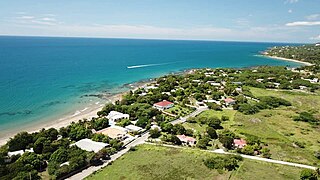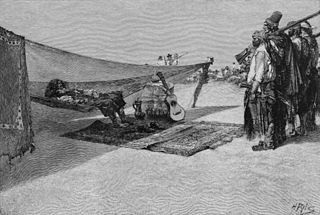
Blauvelt is a hamlet, about 20 miles northwest of New York City. It was a census-designated place, formerly known as Greenbush and then Blauveltville, in the town of Orangetown, Rockland County, New York, United States. It is located north of Tappan, east of Nauraushaun and Pearl River, south of Central Nyack, and west of Orangeburg. As of the 2010 census, the CDP had a population of 5,689.

The Mosquito Coast is an area along the eastern coast of present-day Nicaragua and Honduras. It was named after the local Miskito Nation and was long dominated by British interests and known as the Mosquito Kingdom. From 1860 suzerainty of the area was transferred to Nicaragua with the name Mosquito Reserve, and in November 1894 the Mosquito Coast was militarily incorporated into Nicaragua. However, in 1960, the northern part was granted to Honduras by the International Court of Justice.

Bluefields is the capital of the South Caribbean Autonomous Region in Nicaragua. It was also the capital of the former Kingdom of Mosquitia, and later the Zelaya Department, which was divided into North and South Caribbean Coast Autonomous Regions. It is located on Bluefields Bay at the mouth of the Bluefields River in the municipality of the same name.

Blauvelt State Park is a 644-acre (2.61 km2) undeveloped state park located in the Town of Orangetown in Rockland County, New York, near the Hudson River Palisades. The park's land occupies the site of the former Camp Bluefields, a rifle range used to train members of the New York National Guard prior to World War I. The park is located south of Nyack.

Westmoreland is the westernmost parish in Jamaica, located on the south side of the island. It is situated south of Hanover, southwest of Saint James, and northwest of Saint Elizabeth, in the county of Cornwall. The chief town and capital is Savanna-la-Mar. Negril, a famous tourist destination, is also situated in the parish.
Abraham Blauvelt was a Dutch privateer, pirate and explorer of Central America in the 1630s, after whom both the Bluefield River and the neighboring town of Bluefields, Nicaragua were named.
Mískito Coast Creole or Nicaraguan Creole English is an English-based creole language spoken in coastal Nicaraguan region of Mosquito Coast on the Caribbean Sea; its approximately 40,000 speakers are spread over the RACCN and RACCS regions of Nicaragua. The region, known before 1986 as the Zelaya department, is today administratively separated into two autonomous regions: North Caribbean Coast (RACCN) and South Caribbean Coast (RACCS). Mosquito is the nickname that is given to the region and earlier residents by early Europeans who visited and settled in the area. The term "Miskito" is now more commonly used to refer to both the people and the language.

Bluefields Beach Park is a public beach in Bluefields in the south-east of Westmoreland, Jamaica. It gets very busy at weekends and holidays.

The community of Sephardic Jews in the Netherlands, particularly in Amsterdam, was of major importance in the seventeenth century. The Portuguese Jews in the Netherlands did not refer to themselves as "Sephardim", but rather as "Hebrews of the Portuguese Nation." The Portuguese-speaking community grew from conversos, Jews forced to convert to Catholicism in Spain and Portugal, who rejudaized under rabbinical authority, to create an openly self-identified Portuguese Jewish community. As a result of the expulsions from Spain in 1492 and Portugal in 1496, as well as the religious persecution by the Inquisition that followed, many Spanish and Portuguese Jews left the Iberian peninsula at the end of the 15th century and throughout the 16th century, in search of religious freedom. Some migrated to the newly independent Dutch provinces which allowed Jews to become residents. Many Jews who left for the Dutch provinces were crypto-Jews. Others had been sincere New Christians, who, despite their conversion, were targeted by Old Christians as suspect. Some of these sought to return to the religion of their ancestors. Ashkenazi Jews began migrating to the Netherlands in the mid-seventeenth century, but Portuguese Jews viewed them with ambivalence.
Samuel Axe was an English privateer in Dutch service during the early 17th century.

Treasure Beach is the name given to a stretch of four Jamaican coves and their associated settlements: Billy's Bay, Frenchman's Bay, Calabash Bay and Great (Pedro) Bay.
The history of the Jews in Jamaica predominantly dates back to migrants from Spain and Portugal. Starting in 1509, many Jews began fleeing from Spain because of the persecution of the Holy Inquisition. When the English captured Jamaica from Spain in 1655, the Jews who were living as conversos began to practice Judaism openly. By 1611, the Island of Jamaica had reached an estimated population of 1,500 people. An estimated 75 of those people were described as "foreigners," which may have included some Portuguese Jews. Many Jamaican Jews were involved in the Atlantic slave trade, both owning and trading in enslaved Black people.
Jewish pirates were seafaring Jewish people who engaged in piracy. While there is some mention of the phenomenon in antiquity, especially during the Hasmonean period, most Jewish pirates were Sephardim who operated in the years following the Alhambra Decree ordering the expulsion of Iberia's Jews. Upon fleeing Spain and Portugal, some of these Jews became pirates and turned to attacking the Catholic Empire's shipping as both Barbary corsairs from their refuge in the Ottoman dominions, as well as privateers bearing letters of marque from Spanish rivals such as the United Netherlands.

Between 1665 and 1857, Caribbean pirates and filibusters operated in Lake Nicaragua and the surrounding shores. The Spanish city of Granada, located on the lake, was an important trading centre for much of its early history so it was a prime target for pirates such as Welshman Henry Morgan and freebooters like William Walker.

Santiago was a Spanish territory of the Spanish West Indies and within the Viceroyalty of New Spain, in the Caribbean region. Its location is the present-day island and nation of Jamaica.

The Sack of Campeche was a 1663 raid by pirates led by Christopher Myngs and Edward Mansvelt which became a model for later coastal pirate raids of the buccaneering era.

Couples Resorts is one of the pioneers of the all-inclusive resort concept in the Caribbean. Couples Resorts owns and operates four all-inclusive, couples-only beach resorts on Jamaica’s north coast, between Ocho Rios and Negril.

Maymie de Mena was an American-born activist who became one of the highest-ranking officers in the Universal Negro Improvement Association (UNIA). She has been credited with keeping the organization alive after Marcus Garvey's conviction for mail fraud and deportation from the United States.

Beverley Lois Anderson-Manley is a Jamaican public figure. In the 1970s, she emerged as a leader in women's rights advocacy, leading a campaign for a maternity leave. From 1972 to 1993, she was married to Michael Manley, who was Prime Minister of Jamaica from 1972 to 1980. Manley was known for being more radical than her husband and helping him connect with Jamaica's black population. She was a popular figure among the majority of Jamaicans. Manley also co-founded a radio show with Eric Anthony Abrahams in 1992. After divorcing Michael, she published The Manley Memoirs in 2008, and in 2012 she married Donald Keith Duncan.














